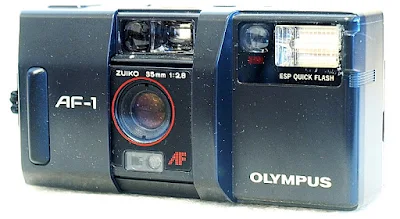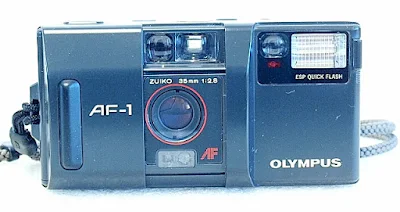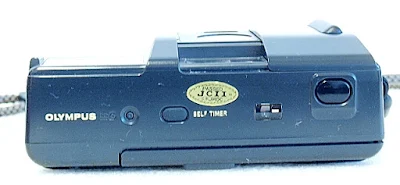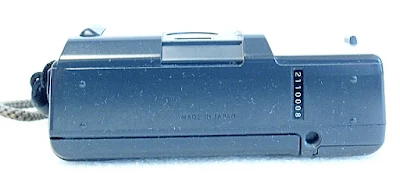The camera came fitted with the Zuiko 35mm F2.8 lens, a continuation of the same lens found on the highly acclaimed Olympus XA, introduced in 1979, and later, the much-acclaimed all-weather Olympus Mju II (Olympus Stylus Epic), introduced in 1997.
Being the middle child between the XA and the Mju II, the AF-1 is, on one hand, the ultimate in single-button operation cameras, or an arms-length shooter, enhanced by auto-everything technology that enables the camera to be used just like the simplest of point-and-shoot cameras.
On the other hand, the AF-1 is also beset by the trend of AF compact cameras, then the infamous non-switchable auto-on flash that tends to activate itself at the slightest chance of a low ambient lighting condition, regardless of any creatives that you may want to capture the image in.
While later model AF cameras come with an auto-focus lock that is enabled with a half-press of the shutter release button, the AF-1 requires a two-handed operation to execute this function, which is quite a juggle to execute.
Thrift Store 35mm Camera Challenge (Olympus AF-1)
Olympus AF-1 ( Fuji Superia 400 ) Song 8-bit vapor trap prod. (Kaybim) Filmed - Travis Sigman @travis_sigman Edit and reviewer - Micah Mullins @photos.bymicah Model - Emerson D @princemerson
Where the AF-1 wins hands down, however, is with its pioneering waterproofing technology, which has evolved as the technology behind today's waterproof cameras, and Olympus is the manufacturer of one.
Basic Camera Features
With a brick-bat design and a front that has the resemblance of an M4 Sherman, the AF-1 is a far cry from the minimalist space capsule of the XA series, and as far away from the curves and the curvatures that are the hallmark of the Mju series.
The strength of the world's first weatherproof, fully automatic 35mm compact camera, nicknamed the 'Nurepika (wet flash)' in Japan, was its features. These include a Zuiko 4-elements in 4-groups 35mm F2.8 lens, a programmed shutter range from F2.8 @ 1/30 sec to F13.5 @ 1/750 sec, DX-coded film ISO range from 50 to 3200, focusing distance from 0.75 meters to infinity, a 12-second delay electronic self-timer, automatic flash in low light and backlight, and, of course, weather-sealing.
Aside from the Zuiko 35mm F2.8 lens, which could have been similar to the one found on the Olympus XA, and later on the Olympus Mju II, the front plane of the camera is rather plain. A slightly ridged XA-style slide covers the lens assembly and powers up the camera when opened. Above the lens housing are the viewfinder window and one-half of the two autofocus triangulation windows, the other being located towards the right just beside the flash unit, below which is the self-timer indicator.
The top plate is again an epitome of simplicity; scattered sparsely over the area are the shutter release button, frame counter window, self-timer hold button, and a miniature mid-roll button.
The back of the camera is equally plain, with only the viewfinder window, the film ID window on the film back, and the focus lock button towards the top-left corner of the camera back. The film back opens from left to right with the latch release located on the right shoulder of the camera body. The battery chamber is located on the left of the camera back, with its cover opening outward from the back.
On the bottom plate, only the tripod socket.
The film box is a quick-load affair, with the film canister reverse-loaded to the right with the pickup spool on the left of the film box. All you need to do is fill the film back across the film frame, push the tab end slightly into the spool area (indicated in red), and close the back. The autoload feature advances the film to Frame 1 and rewinds the roll automatically.
Viewfinder Readout
The viewfinder is a simple, bright frame with frame lines and an autofocus spot etched onto the glass. An Orange LED indicator on the top left corner of the viewfinder frame blinks when auto-flash is activated.
A red low-battery LED indicator is located on the lower right of the viewfinder display when the camera's battery is nearly depleted and needs to be replaced. The Red LED may also blink when the camera is exposed to cold weather, immediately after the lens slide cover is opened, or after the auto-flash is activated.
Battery
The Olympus AF-1 requires a CR-P2 Lithium pack (Duracell DL223A or Panasonic BRP2) to operate.
The camera's body weight is 225 grams without batteries. The camera comes with a pouch and a stylish single-end shoulder strap as a kit.
Using the Camera
Being a straightforward autofocus point-and-shoot, the operation of the camera could not be much simpler. All you need to do is bring the camera to your eye, frame the image, and press the shutter release button. The auto-flash will fire if the camera detects that the ambient lighting condition is low enough to induce a camera shake.
The real test is, of course, a straight comparison between the images shot on this camera compared to images shot on the earlier Olympus XA or the later Olympus MJU II. All three cameras came fitted with 35mm F2.8 lenses, presumably of the same make and construction.
Having said that, I have to admit that I was really excited about these test images shot on a recent photo walk along the whole stretch of Petaling Street, Kuala Lumpur.
The first two images are from the area south of the roofed arcade, while the rest were from the north end, from the roofed arcade end to the start of Petaling Street itself as it branches off from Jalan Pasar Besar.
If you are not familiar with Kuala Lumpur or find the name-sharing not a true relevance, my apologies. Please just enjoy the images as test images of a camera being reviewed.
Ending this presentation is a suggestion that if you have yet to make a decision on waiting and paying such a high price for the much-anticipated Olympus Mju II, the Olympus AF-1 may fit in just right as the poor cousin.





























May i ask what film did u use
ReplyDeleteBen a while, Kodak ColorPlus 200, post-processed on OV3, thanks.
Delete